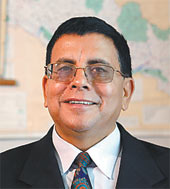 Hari Prasad Bashyal, Nepal’s Former Consul General
Hari Prasad Bashyal, Nepal’s Former Consul General
to Lhasa, Tibet Autonomous Region of China
How do you look back to your tenure as Nepal’s Consular General in Lhasa?
I am satisfied with what I did during my four year stint as Consular General of Lhasa. I mainly contributed to two areas of Nepal-China relations. First, opening more trade routes with China. Khasa-Tatopani was the only operational trade route to China from Nepal then. I took initiative for opening more border points with China following landslide in Jure of Sindhupalchowk in August 2014. It had adversely affected Nepal’s bilateral trade with China. Opening of another trade route through Kerung became possible in December 2014. Delivering essential goods to Gorkha had become more difficult following the devastating earthquakes of April and May of 2015. This led us to opening another border point in Chhekampar of Gorkha. I took initiative to open Kimathanka and Hilsa border points as well. Second, I worked to promote Nepal’s tourism in China. After we eased visa processing and promoted tourism related activities, there has been massive rise in Chinese tourists coming to Nepal. Chinese tourists visiting Tibet are also entering Nepal as visa system in Lhasa has been made a lot easier. Lately, Nepal has waived visa fee for Chinese tourists following the agreement between the two countries. In my estimation, about 200,000 Chinese tourists will visit Nepal in 2016. I take these developments as achievement of my tenure.
There is a concern that China is delaying opening up Khasa border that remains closed after the earthquakes. What’s the truth?
Khasa border point will surely open but it may take time. Earthquakes did not only affect our parts of the border but also China’s. The customs offices and other infrastructure in Chinese side were also damaged. Nepalese have been staying even in partially damaged houses in border towns but China takes its citizens’ safety seriously and has not allowed them to live in vulnerable structures. They will start reconstruction only after conducting geological survey. They are building customs offices at Nyalam town close to Khasa. Nepalese traders are facing hardship due to closure of Khasa border. So I have proposed the Chinese side to lock Nepal-bound goods in Kuti and unload them in Nepal’s dry port in Sindhupalchowk so that Nepali workers do not have to go up to Kuti for loading and unloading purposes.
What about the opening of other border points?
Hilsa border in Nepal’s Humla district is most likely to open very soon as infrastructure has been built on both sides. Road stretching from border point to district headquarters of Humla is under construction. After Khasa-Tatopani and Kerung-Rasuwagadhi, opening Hilsa border point is in priority. The Chinese side has been building an inter national standard port incorporating customs office, police posts there. Kimathanka border point will open soon. Preparations are on full swing on both sides.
Many in Nepal doubt China will open all border points given the sensitivity of Tibet’s security.
China is the country that makes announcement only after making all necessary preparations. Opening border alone does not make sense if it is not supported by workable infrastructures on both sides. Besides, we need to look into security sensitivity of both countries as well.
TAR witnessed unprecedented development during your own tenure. What can Nepal learn from it?
Nepal should learn from Tibet’s political leaders’ commitment towards development. There are disciplined and committed people and efficient government mechanism. We need to learn a lot from them.
It is said Chinese railway will soon reach up to Kerung. How will it benefit Nepal?
Chinese railway is likely to be extended up to Kerung by 2020. It will significantly reduce our import and export costs in doing business with China. We need to build special economic zones in the border areas to take greater economic benefit from improved connectivity with China. Tourism is another area that will benefit from this. It won’t be difficult for us to attract 400,000 to 500,000 tourists per year by railway while we are currently receiving just over 100,000 Chinese tourists.
What can be other areas of economic cooperation between Nepal and TAR?
Nepal exports rice, wheat flour, ready made carpets and handicrafts to Tibet. We import wool from Tibet. Among handicraft products, Nepal-made statute of Buddha is heavily sold in Tibet’s monasteries. Tea, biscuit, chocolate and medicinal herbs are other products being exported to TAR from Nepal. TAR is also importing medicinal herbs from Nepal in large scale. This interaction needs to be further boosted.
How do you see the possibility of power trade from China?
There is this possibility. China has made electricity available to its people living along border areas. There is possibility of export and import of electricity if cross-border transmission lines are constructed. We may import power from China. Likewise we may also export it to China where possible. For example, electricity from hydropower projects in Sankhuwasabha can be exported through Kimathanka point.
(This interview was originally published in Asia Pacific Daily, Kathmandu issue on Feb, 2016)

